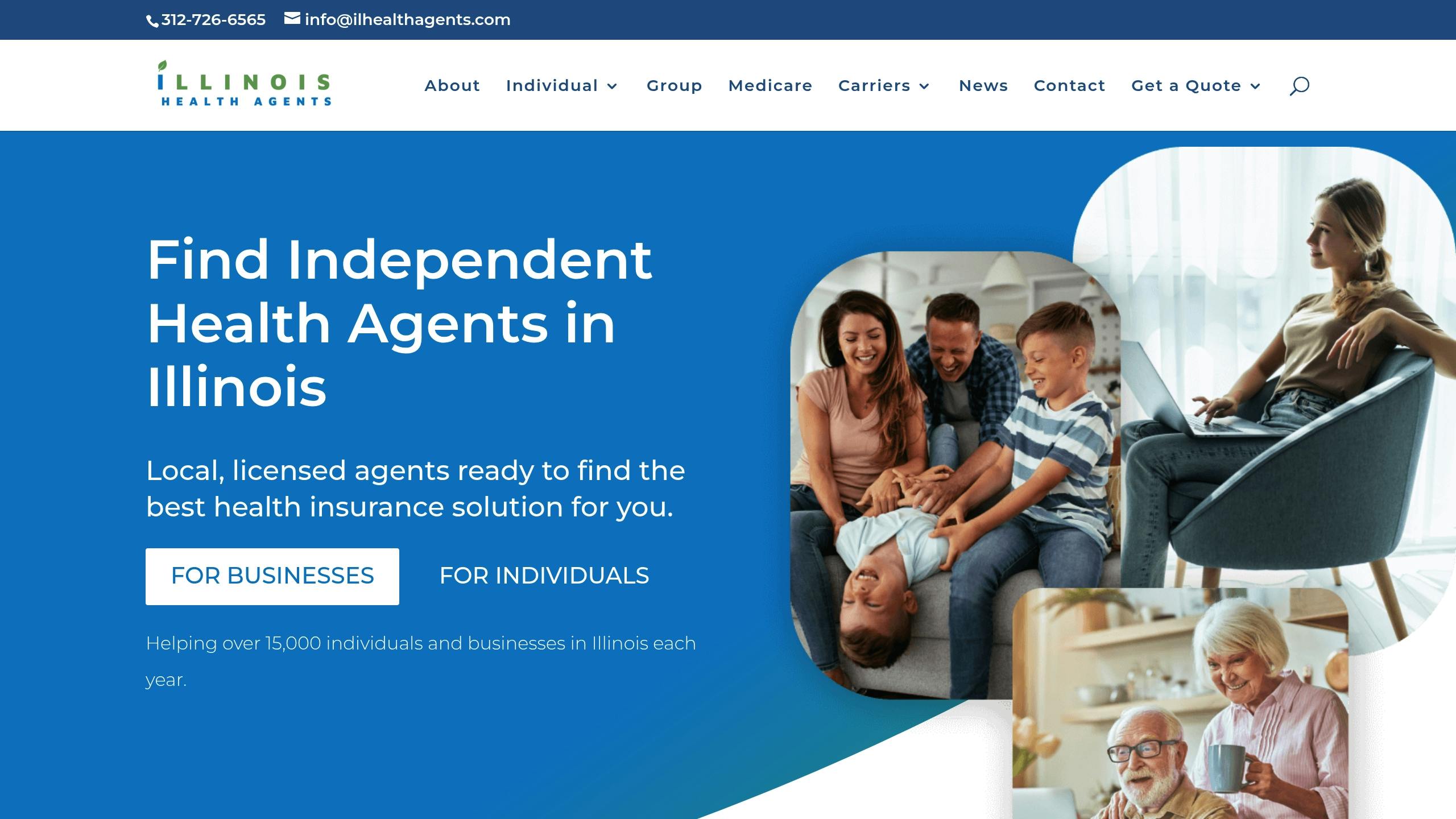Tired of high health insurance costs? Here’s how you can lower your premiums while keeping good coverage:
- Use Tax Credits and Subsidies: If your income falls within eligible ranges, you can save hundreds per month.
- Choose High-Deductible Plans with HSAs: Lower your premiums by 15-30% and enjoy tax benefits.
- Shop Around for Plans: Compare providers and plans using tools like GetCoveredIllinois.gov to find the best deal.
- Enroll at the Right Time: Sign up during Open Enrollment or after qualifying life events to avoid gaps in coverage.
- Work with Insurance Brokers: Brokers can help you find hidden savings and tailor plans to your needs.
- Explore Medicaid Options: If you qualify, Medicaid can provide free or low-cost coverage.
Pro Tip: Combine these strategies to maximize savings and get the coverage that fits your needs. Let’s dive into each method in detail.
5 Things To Remember To Reduce Your Health Insurance Premium
1. Use Available Tax Credits and Subsidies
Reducing your health insurance premiums in Illinois can be much easier if you take advantage of tax credits and subsidies. In 2023, 84% of Illinois marketplace enrollees benefited from premium subsidies, saving an average of $516 per month.
How to Qualify for ACA Tax Credits
The Advanced Premium Tax Credits (APTC) can help lower monthly premiums significantly. For 2025, individuals earning between $14,580 and $58,320 or families of four with incomes from $30,000 to $120,000 are eligible.
Here’s an example: A 40-year-old living in Chicago with an annual income of $30,000 could pay just $85 per month for a Silver plan after subsidies. Without subsidies, the same plan would cost $504 per month – a savings of $419 each month. This aligns with the earlier $456 Silver plan premium mentioned, demonstrating that subsidies can cut costs by over 80%.
To get the most out of your tax credits:
- Report your income accurately when enrolling.
- Choose Silver plans for extra savings opportunities.
- Update your income details right away if there are changes.
These savings can free up your budget, letting you consider other options like high-deductible plans, which we’ll discuss in the next section.
Illinois Medicaid Coverage Options
Illinois has expanded Medicaid coverage under state programs. Individuals earning less than $19,020 or families of four with incomes below $39,000 qualify for Medicaid.
Additionally, Illinois provides health programs for immigrants who don’t qualify for Medicaid, including adults over 42 and seniors.
2. Pick High-Deductible Plans and HSAs
Choosing a high-deductible health plan (HDHP) combined with a Health Savings Account (HSA) can lower your monthly premiums by 15-30%. For instance, a $500 monthly premium might shrink to $350-$425 with an HDHP.
In 2025, HDHP deductibles start at $1,600 for individuals and $3,200 for families. Despite the higher deductible, preventive care services like check-ups, vaccines, and screenings are still fully covered.
HSAs come with three key tax perks:
- Tax-deductible contributions
- Tax-free growth on investments
- Tax-free withdrawals for qualified medical expenses
For 2025, HSA contribution limits are as follows:
- $4,150 for individual coverage
- $8,300 for family coverage
- An additional $1,000 catch-up contribution for those aged 55 and older
Here’s an interesting stat: A 2023 study found that investing $4,300 in an HSA annually for 15 years could grow to $1,325 more than comparable retirement contributions, assuming a 25% tax rate.
After assessing HDHPs, the next step is to compare providers (covered in the following section) to ensure you’re getting the best deal tailored to your needs.
3. Research Different Plans and Providers
Shopping around for health insurance in Illinois can help you save a lot on monthly premiums. The trick is knowing what to compare and where to start looking.
Tools to Compare Illinois Health Plans
To compare plans effectively, check out GetCoveredIllinois.gov and the IDOI Consumer Health Insurance Search tool. When comparing, focus on total yearly costs – sometimes a plan with a higher monthly premium but lower deductibles can end up being cheaper overall. For example, a $400/month plan might save you more than a $350/month plan if the deductibles are significantly lower.
Key tools to explore include:
- Illinois Department of Insurance Comparison Tool: Offers insights into both marketplace and off-marketplace plans.
- IDOI Consumer Health Insurance Search (CHIS): Provides detailed information about specific policy features.
City vs. Rural Insurance Costs
Where you live in Illinois has a big impact on your health insurance costs. Here’s a quick look at how Silver plan prices differ depending on location:
| Location | Average Monthly Premium | Provider Options |
|---|---|---|
| Cook County (Chicago) | $597 | Multiple carriers |
| Southern Illinois (Rural) | $456 | Limited carriers |
In rural areas, fewer insurance providers often lead to higher premiums, even though local healthcare costs might be lower.
Pro tip: If you live near a county border, compare plans in nearby counties. Some residents save money by choosing plans from neighboring areas while still keeping access to their preferred doctors and hospitals.
For rural residents, higher premiums can be managed by:
- Exploring telemedicine options, which can help cut costs.
Once you’ve compared your options, enrolling at the right time can also help you save even more.
sbb-itb-a729c26
4. Choose the Right Time to Enroll
After reviewing and comparing plans, timing your enrollment can help you save on premiums and avoid unnecessary costs.
The Open Enrollment Period (OEP) for 2025 coverage runs from November 1, 2024, to January 15, 2025. During this time, anyone can sign up for a health insurance plan without needing a specific life event, and insurers often offer competitive pricing.
If you miss the OEP, you might still qualify for a Special Enrollment Period (SEP) if you experience certain life changes:
| Qualifying Event | Enrollment Window |
|---|---|
| Marriage/Divorce | 60 days after the event |
| Birth/Adoption | 60 days after the event |
| Loss of Coverage | 60 days after the event |
| Moving to a New Area | 60 days after the event |
Tip: Don’t wait until the end of your 60-day window. Acting quickly ensures you avoid any gaps in coverage.
2025 Illinois Insurance Rate Changes
Illinois residents should be aware of possible premium increases for 2025. In 2024, the state experienced an average rate increase of 11.3%. To manage these changes effectively:
- Consider switching Metal Tiers. For instance, in Chicago, a 30-year-old could expect:
- Bronze plan: $243/month
- Silver plan: $331/month
- Gold plan: $355/month
"Rate changes can vary significantly between insurers and plan types. Knowing the overall trend helps consumers evaluate if their current plan’s rate change is in line with market averages." – Illinois Department of Insurance
Enrolling early allows you to secure current-year subsidies before any rate hikes take effect.
5. Get Help from Insurance Brokers
Enrolling at the right time can save you money, but working with insurance brokers can take those savings even further. Brokers use their expertise to handle tasks like comparing plans, optimizing subsidies, and pairing plans with HSAs. In fact, data shows that small businesses save an average of 13% on health insurance premiums when they work with a broker.
Why Use an Insurance Broker
Brokers bring several benefits to the table that can help lower your premiums:
| Broker Advantage | How It Saves You Money |
|---|---|
| Multi-insurer rate comparisons | Helps find the best deals by comparing various insurers |
| Customized coverage matching | Ensures you only pay for coverage you actually need |
"67% of consumers who used a broker reported receiving better coverage than if they had shopped on their own, often at lower premium costs due to brokers’ ability to identify overlooked savings opportunities."
Brokers are paid through commissions from insurance companies, which typically range between 2% and 8% of the premium. Since this cost is already factored into the premium, using a broker won’t cost you extra.
Illinois Health Agents Services

Illinois Health Agents offers tailored services to help individuals, families, and businesses lower their insurance costs:
For individuals and families, they provide:
- Subsidized ACA plan comparisons and Medicare/STC evaluations
- Pairing supplemental coverage for added savings
For businesses, their services include:
- Designing group health plans with employer contribution strategies
- Annual reviews to fine-tune coverage
- Employee education programs to explain benefits
- Digital tools to simplify enrollment
Pricing Details:
- Free for groups with more than 10 employees; $250/year fee waived for smaller groups if at least 10 employees enroll
- No direct broker fees for individual or family plans
Pro Tip: Once you’ve chosen your plan’s metal tier, ask brokers detailed questions about their relationships with carriers and strategies they use to cut costs.
Conclusion: Steps to Lower Your Premiums
Reducing premiums while keeping quality healthcare coverage is possible by applying a mix of smart strategies, from taking advantage of subsidies to working with brokers.
Start by using resources like the Illinois Department of Insurance website and the Get Covered Illinois platform to compare plans and uncover savings. Here are some key steps to consider:
- Use ACA subsidies: These are available for individuals earning 100-400% of the Federal Poverty Level.
- Combine HDHPs with HSAs: High-deductible health plans (with deductibles of $1,600 or more) paired with Health Savings Accounts can help cut costs.
- Shop around: Compare rates from multiple providers using state tools to find the best options.
- Enroll strategically: Sign up during Open Enrollment or after qualifying life events for the best timing.
- Consult brokers: Get expert advice to uncover savings opportunities and optimize your plan.
High-deductible health plans are increasingly popular among Illinois residents, offering a practical way to manage healthcare costs. Families of four earning between $27,750 and $111,000 may also qualify for premium subsidies, making coverage more affordable.
As mentioned earlier, scheduling yearly reviews with your insurance broker can help you reassess your needs and pinpoint additional savings. Staying updated on Illinois-specific insurance options ensures you can balance cost and coverage effectively.
Pro Tip: Keep track of your annual medical expenses to make the most of HSA tax benefits and ensure your coverage continues to meet your healthcare needs.
FAQs
How can I lower my health insurance premiums?
One way is to take full advantage of ACA tax credits. In Illinois, residents earning 100-400% of federal poverty levels can often save over $300 per month. This ties into strategies covered in sections 1 and 4, which explain how to qualify for and maximize these subsidies.
What are some ways to reduce the amount I pay for health insurance premiums?
Switching to a High-Deductible Health Plan (HDHP) paired with a Health Savings Account (HSA) can help. For 2025, you can make tax-free HSA contributions of up to $4,150 for individuals or $8,300 for families. Section 2 explains how these contributions can lead to long-term savings.
What are practical steps to reduce health insurance premiums?
Here are three effective approaches:
- Review your plan annually during Open Enrollment: Use state tools to find options that better fit your needs.
- Take advantage of preventive health screenings: These can lead to premium discounts of 5-15%.
- Work with a broker: Brokers can help you find exclusive plans that might not be publicly listed (explained in section 5).
These tips build on the strategies discussed throughout sections 1-5.




0 Comments